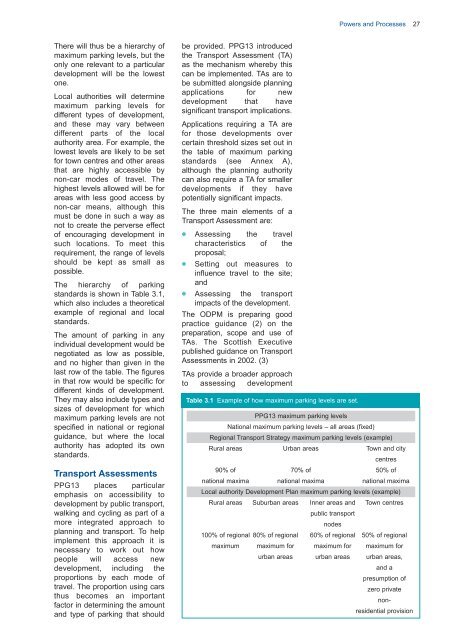titlepage/contents pg 1-16 - British Parking Association
titlepage/contents pg 1-16 - British Parking Association
titlepage/contents pg 1-16 - British Parking Association
You also want an ePaper? Increase the reach of your titles
YUMPU automatically turns print PDFs into web optimized ePapers that Google loves.
Powers and Processes 27There will thus be a hierarchy ofmaximum parking levels, but theonly one relevant to a particulardevelopment will be the lowestone.Local authorities will determinemaximum parking levels fordifferent types of development,and these may vary betweendifferent parts of the localauthority area. For example, thelowest levels are likely to be setfor town centres and other areasthat are highly accessible bynon-car modes of travel. Thehighest levels allowed will be forareas with less good access bynon-car means, although thismust be done in such a way asnot to create the perverse effectof encouraging development insuch locations. To meet thisrequirement, the range of levelsshould be kept as small aspossible.The hierarchy of parkingstandards is shown in Table 3.1,which also includes a theoreticalexample of regional and localstandards.The amount of parking in anyindividual development would benegotiated as low as possible,and no higher than given in thelast row of the table. The figuresin that row would be specific fordifferent kinds of development.They may also include types andsizes of development for whichmaximum parking levels are notspecified in national or regionalguidance, but where the localauthority has adopted its ownstandards.Transport AssessmentsPPG13 places particularemphasis on accessibility todevelopment by public transport,walking and cycling as part of amore integrated approach toplanning and transport. To helpimplement this approach it isnecessary to work out howpeople will access newdevelopment, including theproportions by each mode oftravel. The proportion using carsthus becomes an importantfactor in determining the amountand type of parking that shouldbe provided. PPG13 introducedthe Transport Assessment (TA)as the mechanism whereby thiscan be implemented. TAs are tobe submitted alongside planningapplications for newdevelopment that havesignificant transport implications.Applications requiring a TA arefor those developments overcertain threshold sizes set out inthe table of maximum parkingstandards (see Annex A),although the planning authoritycan also require a TA for smallerdevelopments if they havepotentially significant impacts.The three main elements of aTransport Assessment are:● Assessing the travelcharacteristics of theproposal;● Setting out measures toinfluence travel to the site;and● Assessing the transportimpacts of the development.The ODPM is preparing goodpractice guidance (2) on thepreparation, scope and use ofTAs. The Scottish Executivepublished guidance on TransportAssessments in 2002. (3)TAs provide a broader approachto assessing developmentTable 3.1 Example of how maximum parking levels are set.PPG13 maximum parking levelsNational maximum parking levels – all areas (fixed)Regional Transport Strategy maximum parking levels (example)Rural areas Urban areas Town and citycentres90% of 70% of 50% ofnational maxima national maxima national maximaLocal authority Development Plan maximum parking levels (example)Rural areas Suburban areas Inner areas and Town centrespublic transportnodes100% of regional 80% of regional 60% of regional 50% of regionalmaximum maximum for maximum for maximum forurban areas urban areas urban areas,and apresumption ofzero privatenonresidentialprovision







